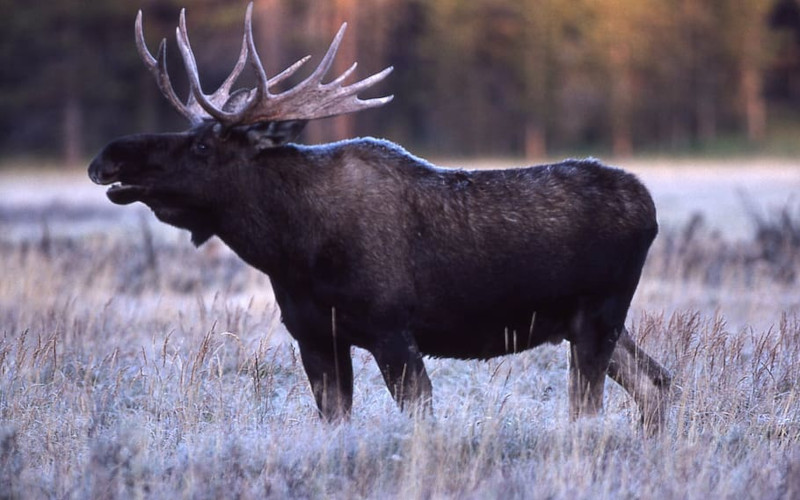
Moose Facts
- This massive and magnificent mammal most frequently goes by the simple name of Moose within a certain portion of its range. Intriguingly, however, it holds a different common name in another part of its territory. That’s the equally short moniker of Elk.
- Inside of the scientific community, though, the animal is generally better known by its technical title. Thankfully for the layperson, that’s an extremely simple term to pronounce compared to most. That’s because it holds the formal title of Alces alces.
- The remarkable creature received that easy to pronounce name due to the efforts of Carl Linnaeus. The Swedish zoologist accomplished the first official recognition of it as a separate and distinct species. That noteworthy event occurred in 1758.
- Regardless of which of these one chooses to use, it remains an impressive species. It also stands out from it kindred for several reasons. Perhaps most impressively, it’s the largest extant species in the deer family. It’s also the only member of its genus.
- Luckily, the Moose seems to be maintaining a sizeable and comparatively stable population. That pleasant situation further appears to hold true throughout its entire habitat range. The IUCN, therefore, currently lists it as Least Concern on its Red List.
- The majestic animal nevertheless faces the same potential threats to its existence as most species. Most of these stem from the actions of humans. They include such dangers as habitat loss due to human expansion, and climate change, of course.
Related Articles
Moose Physical Description
The incredible Moose clearly distinguishes itself from all other known varieties of deer. Obviously, its most attention-grabbing attribute is its sheer size. Yet it certainly holds the appreciation of Nature lovers due to its appearance, as well. Nature truly blessed this marvel.
Though larger than its relatives, it follows a similar pattern regarding its nature. That’s the fact that the animal displays a moderate degree of the physiological characteristic of sexual dimorphism. In its case, this trait manifests itself in not one, but two distinct manners.
In terms of pure size, males of the species attain greater average measurements than do their female counterparts. Males reach a height at the shoulder ranging from roughly 4.5 – 7 ft (1.4 – 2.1 m). These also range in weight from an incredible 838 – 1,543 lb (380 – 700 kg)!
Females, however, reach noticeably smaller dimensions, in both of these categories. These typically have masses ranging from 441 – 1,080 lb (200 – 490 kg). Their overall body height and length also remain accordingly smaller than the males of the remarkable Cervidae.
The nose of both sexes stands out from others of its kind, too. It’s unique among living cervids due to its significantly greater length, relative to body size. The creature also evolved an adaptation allowing it to seal its own nostrils when feeding on aquatic vegetation.
Its the antlers of the Moose that most separate the genders, however. Females lack this feature entirely. Among males, though, these reach impressive dimensions. This varies with age and range, but averages an extraordinary 79 in (2 m) among healthy, mature adults!
- Kingdom: Animalia
- Phylum: Chordata
- Class: Mammalia
- Order: Artiodactyla
- Family: Cervidae
- Genus: Alces
- Species: A. alces
Moose Distribution, Habitat, and Ecology
The extraordinary Moose evolved as native to an extremely wide expanse of the globe. The full extent of that territory surprises many people. That’s because the intriguing mammal developed as endemic to sections of North America, Europe, and a small part of Asia.
In North America, that range covers virtually all of Canada. It also appears in Alaska, and the most northerly portions of the United States. In Europe, though, the animal lives in such countries as Sweden, Norway, and Finland. But in Asia, it’s mainly confined to Russia.
The fascinating creatue evolved very precise preferences for its choice of habitat. As a general principle, individuals avoid regions with little or no snow. Their evolutionary cold-adaptations make this a necessity. They typically try to avoid hotter regions for that reason.
The animal also requires the presence of sufficient vegetation of the appropriate kind. The species most commonly prefers sub-alpine areas where possible, in early winter. During the latter part of that season, however, they move to river valleys with deciduous forests.
The mighty Moose evolved as a browsing herbivore. It feeds opportunistically on an extremely wide variety of flora. This includes such fare as aquatic plants, fruit, and tree shoots. The average adult individual consumes approximately 71 lb (32 kg) of food per day!
The massive mammal understandably has few natural predators, due to its great size. Only siberian tigers hunt mature individuals solo. Packs of wolves sometimes will as a group, though. In certain parts of its range, black bears and cougars sometimes prey on the calves.
Species Sharing Its Range
Check out our other articles on 5 Marvelous Mediterranean Sea Species, Southern Plains Bumblebee, Great Barrier Reef, Alligator Snapping Turtle, 3 Beguiling Birds of Europe, Serval
